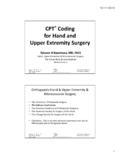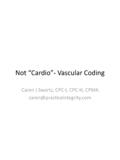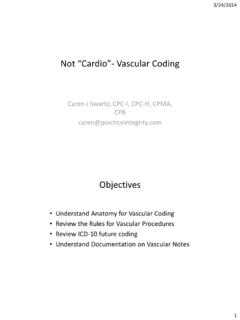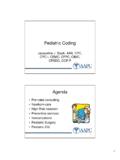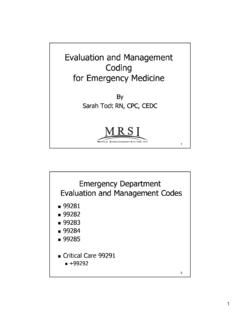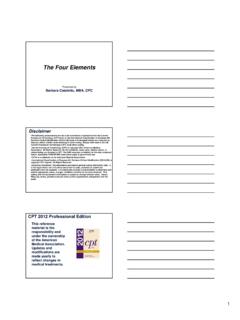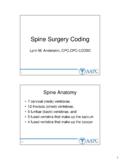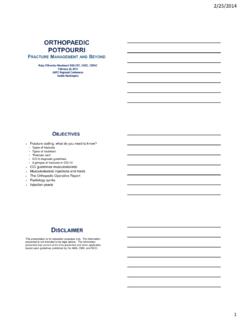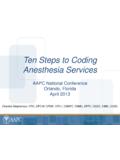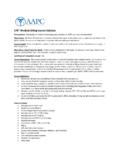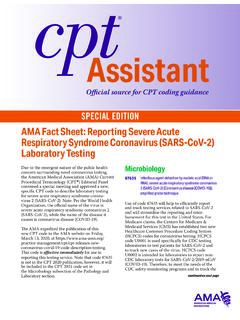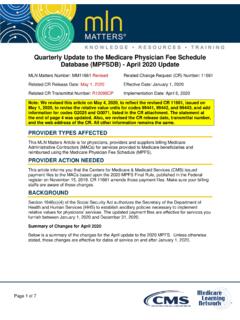Transcription of Billing Incident-to Services - AAPC
1 Incident-to / Split-Shared Billing for Medicare Presented by: Michael D. Miscoe, Esq, CPC, CASCC, CUC, CCPC, CPCO, CHCC CPT codes, descriptions and material only are Copyright 2012 American Medical Association. All Rights Reserved. DISCLAIMER DISCLAIMER This presentation is for general education purposes only. The information contained in these materials, lecture, ideas and concepts presented is not intended to be, and is not, legal advice or even particular business advice relevant to your personal circumstances. The laws and regulations presented in this lecture are open to interpretation. It is your responsibility to seek private counsel with your attorney to determine how these laws , regulations, policies and forms as the concepts discussed apply to your specific case before applying the concepts addressed in this lecture.
2 Attendance at this presentation should not be construed as creating an attorney client relationship with the speaker nor should the information presented be construed as legal advice. Remaining for this presentation indicates your acknowledgement and agreement with the above. 2 NOTICES THIS PRESENTATION ADDRESSES THE CONCEPTS OF Incident-to AND SPLIT/SHARED Billing FROM THE STANDPOINT OF CMS GUIDANCE ONLY. THESE CONCEPTS MAY OR MAY NOT APPLY IN COMMERCIAL INSURANCE Billing SCENARIOS. CHECK LOCAL CARRIER MEDICAL POLICIES TO DETERMINE THE APPROPRIATENESS OF APPLYING CMS RULES IN THOSE Billing SCENARIOS. NOTICES Current Procedural Terminology (CPT ) is copyright 2012 American Medical Association. All Rights Reserved. CPT is a registered trademark of the American Medical Association (AMA).
3 Mr. Miscoe is admitted to the practice of law in California (Cal Bar ID 260146) and the US District Courts in the Southern District of California and the Western District of Pennsylvania. 3 Review CMS Rules regarding Incident-to Services . To define who can perform Incident-to Services . Outline relevant case-law pertaining to Incident-to Billing issues. Review CMS Rules regarding Split/Shared E/M Services . Course Objective 4 What is Incident-to ?? 5 Internet Only Manual (IOM) Publication 100-2, Chapter 15, Section 60 CMS Guidance 6 Core Elements Non-Institutional Setting All settings other than a hospital or SNF Services that are usually not self-administered An integral, although incidental, part of the physician s professional service (see ); Services are of a type that are commonly furnished in physician s offices or clinics (see ); Furnished by the physician or by auxiliary personnel under the physician s direct supervision (see ).
4 7 Office within an Institution Must be confined to a separately identified part of the facility used solely as the physician s office and Cannot be construed to extend throughout the entire institution physician must be in office suite to establish direct supervision. Services performed outside the office area Subject to the coverage rules outside the office setting Non-Institutional Requirement 8 incident to a physician s professional Services means that the Services or supplies are furnished as an integral, although incidental, part of the physician s personal professional Services in the course of diagnosis or treatment of an injury or illness. Narrative Definition 9 What is the Compliance Issue? Consider this Service is Performed by Auxiliary personnel. The service is then reported under the name/PTAN of the physician If extender is a NPP authorized to be reimbursed directly, Medicare Pays the full fee allowance under the MPFS rather than the 85% that the NPP would be entitled to.
5 If the extender is not a NPP authorized to be reimbursed directly, the entire payment may be improper. What is misrepresented on the claim that led to the improper payment? 10 Medicare generally requires that the identity of the person who actually performed the service be reported on the claim. The I2 Rule is an exception that permits reporting of Services actually performed by one person to be reported under the name of another provided that certain requirements are met. General Rule 11 Integral Although Incidental Axiomatic in this requirement is that the physician is controlling the management of the patient s condition Translation The physician MUST initiate the care but need not render a physician service at each instance of I2 Billing ; however,.. The physician must remain actively involved in the care Changes in condition being managed?
6 I2 Elements 12 Initial Service Requirement To bill Incident-to , there must have been a direct, personal, professional service furnished by a the physician to initiate the course of treatment of which the service being performed by the non- physician practitioner is an incidental part, and there must be subsequent Services by the physician of a frequency that reflects his/her continuing active participation in and management of the course of treatment. I2 Elements 13 Established Plan of Care The personnel performing the Incident-to service should: Document the link between their face-to-face service of the preceding physician service to which their service in incidental. Reference by date and location the precedent providers service that supports the active involvement of the physician .
7 Legibly record both their identity and credentials Legibly record the supervising physician for the encounter I2 Elements 14 Commonly Furnished in physician s Offices Services and supplies commonly furnished in physicians offices are covered under the incident to provision. Where supplies are clearly of a type a physician is not expected to have on hand in his/her office or where Services are of a type not considered medically appropriate to provide in the office setting, they would not be covered under the incident to provision. I2 Elements 15 Direct Personal Supervision Coverage of Services and supplies incident to the professional Services of a physician in private practice is limited to situations in which there is direct physician supervision of auxiliary personnel. I2 Elements 16 Direct Personal Supervision Who are auxiliary personnel?
8 Any individual who is acting under the supervision of a physician , regardless of whether the individual is an employee, leased employee, or independent contractor of the physician , or of the legal entity that employs or contracts with the physician . Likewise, the supervising physician may be an employee, leased employee or independent contractor of the legal entity Billing and receiving payment for the Services or supplies. I2 Elements 17 Auxiliary Personnel Any individual CMS deliberately chose this term when defining auxiliary personnel So that the physician (or other practitioner), under his or her discretion and license, may use the service of anyone ranging from another physician to a medical assistant ..impossible to exhaustively list all Incident-to Services and those specific auxiliary personnel who may perform each service.
9 Federal Register, Vol. 66, No. 212, pp 55267-55268 (November 1, 2001). I2 Elements 18 Auxiliary Personnel CMS Guidance In addition to coverage being available for the Services of such auxiliary personnel as nurses, technicians, and therapists when furnished incident to the professional Services of a physician (as discussed in ), a physician may also have the Services of certain nonphysician practitioners covered as Services incident to a physician s professional Services . These nonphysician practitioners, who are being licensed by the States under various programs to assist or act in the place of the physician , include, for example, certified nurse midwives, clinical psychologists, clinical social workers, physician assistants, nurse practitioners, and clinical nurse specialists.
10 (See 150 through 200 for coverage instructions for various allied health/nonphysician practitioners Services .) IOM Pub 100-2, Ch. 15 The Key is Licensure I2 Elements 19 Direct Personal Supervision Direct supervision in the office setting does not mean that the physician must be present in the same room with his or her aide. However, the physician must be present in the office suite and immediately available to provide assistance and direction throughout the time the aide is performing Services . I2 Elements 20 ex rel Lockyer v. Hawaii Pacific Health, 490 F. Supp. 2d 1062 (D. Hawaii 2007) The incident to rule requires the provider submitting a claim, or the group practice submitting the claim on behalf of its members, to ensure he or she provides direct supervision.
